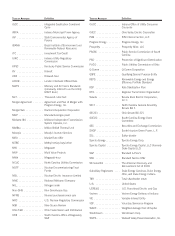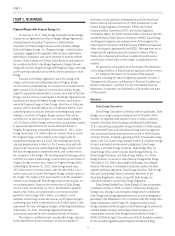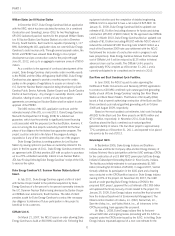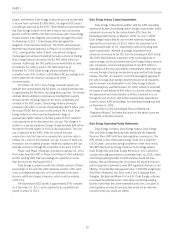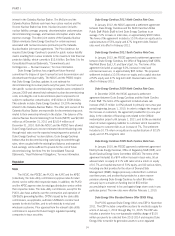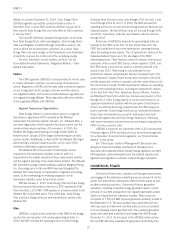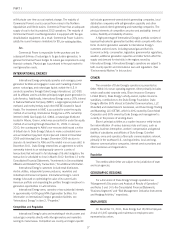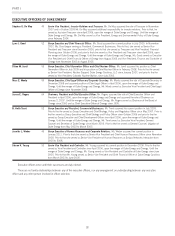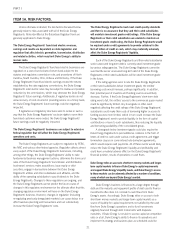Duke Energy 2011 Annual Report Download - page 34
Download and view the complete annual report
Please find page 34 of the 2011 Duke Energy annual report below. You can navigate through the pages in the report by either clicking on the pages listed below, or by using the keyword search tool below to find specific information within the annual report.
PART I
interest in the Catawba Nuclear Station. The McGuire and the
Catawba Nuclear Stations each have two nuclear reactors and the
Oconee Nuclear Station has three. Nuclear insurance includes:
nuclear liability coverage; property, decontamination and premature
decommissioning coverage; and business interruption and/or extra
expense coverage. The other joint owners of the Catawba Nuclear
Station reimburse Duke Energy Carolinas for certain expenses
associated with nuclear insurance premiums per the Catawba
Nuclear Station joint owner agreements. The Price-Anderson Act
requires Duke Energy Carolinas to provide for public nuclear liability
claims resulting from nuclear incidents to the maximum total financial
protection liability, which currently is $12.6 billion. See Note 5 to the
Consolidated Financial Statements, “Commitments and
Contingencies — Nuclear Insurance,” for more information.
Duke Energy Carolinas has a significant future financial
commitment to dispose of spent nuclear fuel and decommission and
decontaminate the plant safely. The NCUC and the PSCSC require
that Duke Energy Carolinas updates its cost estimate for
decommissioning its nuclear plants every five years, the most recent
site-specific nuclear decommissioning cost studies were completed in
January 2009 and showed total estimated nuclear decommissioning
costs, including the cost to decommission plant components not
subject to radioactive contamination, of $3 billion in 2008 dollars.
This estimate includes Duke Energy Carolinas’ 19.25% ownership
interest in the Catawba Nuclear Station. The other joint owners of the
Catawba Nuclear Station are responsible for decommissioning costs
related to their ownership interests in the station. The balance of the
external Nuclear Decommissioning Trust Funds (NDTF) was $2,060
million as of December 31, 2011 and $2,014 million as of
December 31, 2010. Both the NCUC and the PSCSC have allowed
Duke Energy Carolinas to recover estimated decommissioning costs
through retail rates over the expected remaining service periods of
Duke Energy Carolinas’ nuclear stations. Duke Energy Carolinas
believes that the decommissioning costs being recovered through
rates, when coupled with the existing fund balance and expected
fund earnings, will be sufficient to provide for the cost of future
decommissioning. See Note 9 to the Consolidated Financial
Statements, “Asset Retirement Obligations,” for more information.
Regulation
State
The NCUC, the PSCSC, the PUCO, the IURC and the KPSC
(collectively, the state utility commissions) approve rates for retail
electric service within their respective states. In addition, the PUCO
and the KPSC approve rates for retail gas distribution service within
their respective states. The state utility commissions, except for the
PUCO, also have authority over the construction and operation of
USFE&G’s generating facilities. CPCN’s issued by the state utility
commissions, as applicable, authorize USFE&G to construct and
operate its electric facilities, and to sell electricity to retail and
wholesale customers. Prior approval from the relevant state utility
commission is required for Duke Energy’s regulated operating
companies to issue securities.
Duke Energy Carolinas 2011 North Carolina Rate Case.
In January 2012, the NCUC approved a settlement agreement
between Duke Energy Carolinas and the North Carolina Utilities
Public Staff (Public Staff) to limit Duke Energy Carolinas to an
average 7.2% increase in retail rates, or approximately $309 million.
The terms of the agreement included a 10.5% return on equity and a
capital structure of 53% equity and 47% long-term debt. Revised
rates went into effect in February 2012.
Duke Energy Carolinas 2011 South Carolina Rate Case.
In January 2012, the PSCSC approved a settlement agreement
between Duke Energy Carolinas, the Office of Regulatory Staff (ORS),
Wal-Mart Stores East, LP, and Sam’s East, Inc. The terms of the
agreement included an average 6.0% increase in retail and
commercial revenues, or approximately $93 million. The proposed
settlement included a 10.5% return on equity and a capital structure
of 53% equity and 47% long-term debt. Revised rates went into
effect in February 2012.
Duke Energy Carolinas 2009 North Carolina Rate Case.
In December 2009, the NCUC approved a settlement
agreement between Duke Energy Carolinas and the North Carolina
Public Staff. The terms of the agreement included a base rate
increase of $315 million (or 8%) phased in primarily over a two-year
period beginning January 1, 2010. In order to mitigate the impact of
the increase on customers, the agreement provided for (i) a one-year
delay in the collection of financing costs related to the Cliffside
modernization project until January 1, 2011; and (ii) the accelerated
return of certain regulatory liabilities to customers which lowered the
total impact to customer bills to an increase of 7%. The settlement
included a 10.7% return on equity and a capital structure of 52.5%
equity and 47.5% long-term debt.
Duke Energy Carolinas 2009 South Carolina Rate Case.
In January 2010, the PSCSC approved a settlement agreement
filed by Duke Energy Carolinas, Office of Regulatory Staff (ORS), and
South Carolina Energy Users Committee (SCEUC) The terms of the
agreement included (i) a $74 million increase in base rates, (ii) an
allowedreturnonequityof11%withratessetatareturnonequity
of 10.7% and capital structure of 53% equity, and (iii) various riders,
including one that provides for the return of Demand Side
Management (DSM) charges previously collected from customers
over three years, and another that provides for a storm reserve
provision allowing Duke Energy Carolinas to collect $5 million
annually (up to a maximum funding level of $50 million
accumulating in reserves) to be used against large storm costs in any
particular period. The new rates were effective February 1, 2010.
Duke Energy Ohio Standard Service Offer (SSO) Filing.
The PUCO approved Duke Energy Ohio’s new ESP in November
2011. The ESP includes competitive auctions for electricity supply for
a term of January 1, 2012 through May 31, 2015. The ESP also
includes a provision for a non-bypassable stability charge of $110
million per year to be collected from 2012-2014 and requires Duke
Energy Ohio to transfer its generation assets to a non-regulated
14


